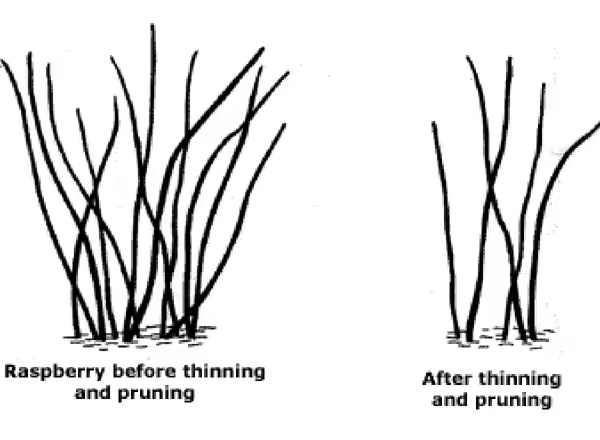Trellis is a supporting open frame used for training raspberries. Trellising affects plant growth rate, competition with suckers, harvesting methods, fruit quantity and quality, disease and insect pest management.
- Red and yellow raspberry (within row 2-3 ft, between rows 10 ft) with low trellis.
- Black raspberry (within row 3-4 ft, between rows 10-12 ft) have spreading and drooping habit with low trellis.
- Purple raspberry (within rows 3-5 ft, between rows 12 ft similar spacing for erect raspberries) more vigorous than black raspberry does not require trellis.
Primocane fruiting types (first year canes bear fruits)
Fruits produced on tops of long canes tend to lean to ground hence need support, temporary trellising during harvesting to facilitate movement between plant rows. T-trellis is commonly used. A T-trellis consists of a T-shaped wooden or metal posts, seven foot long, and three foot long cross arms with screw eyes for holding twine rope or wire. The post is set up into a three foot deep hole in the center of each row, which is slightly wider than the post diameter. A 3 foot PVC pipe can be set into the hole immediately after they are dug to prevent them from collapsing. The holes are dug 25-30 feet apart within rows. The posts can be removed and used the following year while the buried PVC pipe is left in the ground. Canes are cut close to the ground after harvest in late summer.
Floricane fruiting types (second year canes bear fruits)
Canes remain intact in winter through the next growing season, needs support for both floricanes and primocanes, V-trellis is commonly used to separate fruiting and vegetative canes. V-trellis consists of two posts placed on the ground at 20-30 degree angle opposite each other at the outer margins of the plant row forming a V-shaped structure. Floricanes are tied to the outside and primocanes grow in the middle of the V-shape. Floricanes are cut after harvest. Primocanes that will bear fruits the following year are thinned to avoid competition.

- Produces fruits at the top of the first year canes in late summer and in the lower portions of the same canes in early summer of the second year.
- Fruit quality of early summer crop is low.
- For a single late season crop harvest, canes are cut very close to the ground in December to February. Remove the canes and destroy.
- Berry number per lateral and the number of canes can influence the yield; hence, maximize the number of canes per acre in the fall crop.
- Use a T- trellis system with strings to support the cane-bearing fruits.

- Fruits produced from buds on second year canes (Red, Yellow, and Purple types).
- Canes (primocanes) left intact in winter until the end of summer harvest. Flowering and fruiting canes (floricanes) occurs in second year while canes that will bear fruits next year start growing. Cut the floricanes after harvest.
- Pruning is necessary to minimize interference.
- The following year, top and thin remaining canes to 3-4 canes per square feet. Thinning can continue in spring and early summer.
- Pinch primocanes in early summer at a height of 28 inches to stimulate branching by removing about four inches of the tip.
- Support laterals by trellis wire in fall.
- Black raspberries need more care and are less winter hardy (cover with soil or mulch during winter).
- Raspberry with primocanes and floricanes (primocanes are first year growth and in second year they grow into floricanes which bear fruits).